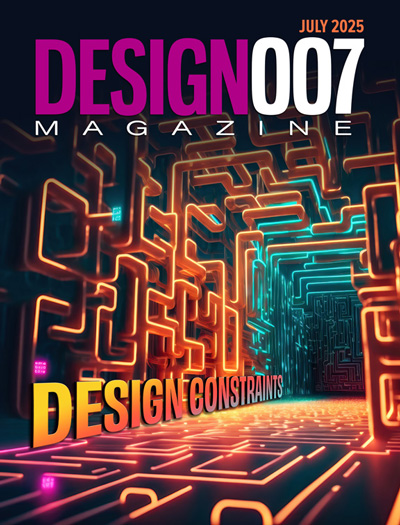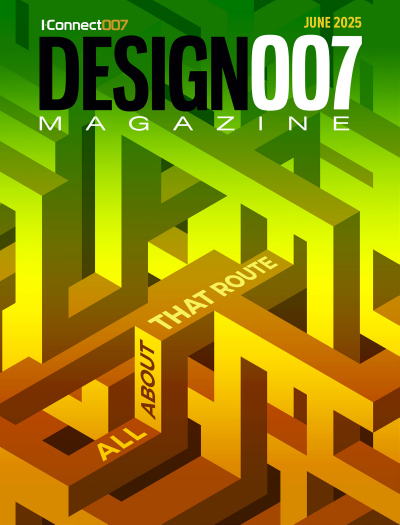-

- News
- Books
Featured Books
- design007 Magazine
Latest Issues
Current Issue
Proper Floor Planning
Floor planning decisions can make or break performance, manufacturability, and timelines. This month’s contributors weigh in with their best practices for proper floor planning and specific strategies to get it right.

Showing Some Constraint
A strong design constraint strategy carefully balances a wide range of electrical and manufacturing trade-offs. This month, we explore the key requirements, common challenges, and best practices behind building an effective constraint strategy.

All About That Route
Most designers favor manual routing, but today's interactive autorouters may be changing designers' minds by allowing users more direct control. In this issue, our expert contributors discuss a variety of manual and autorouting strategies.
- Articles
- Columns
- Links
- Media kit
||| MENU - design007 Magazine
How Swarms of Nanomachines Could Improve the Efficiency of Any Machine
September 27, 2018 | University of LuxembourgEstimated reading time: 1 minute
The research team of Prof. Massimiliano Esposito of the University of Luxembourg studied the thermodynamics of small nanomachines.
All machines convert one form of energy into another form—for example a car engine turns the energy stored in fuel into motion energy. Those processes of energy conversion, described by the theory called thermodynamics, don’t only take place on the macro-level of big machines, but also at the micro-level of molecular machines that drive muscles or metabolic processes and even on the atomic level. The research team of Prof. Massimiliano Esposito of the University of Luxembourg studies the thermodynamics of small nanomachines only consisting of a few atoms. In a paper published in the prestigious scientific journal Physical Review X, they outline how these small machines behave in concert. Their insights could be used to improve the energy efficiency of all kinds of machines, big or small.
Recent progress in nanotechnology has enabled researchers to understand the world in ever-smaller scales and even allows for the design and manufacture of extremely small artificial machines. “There is evidence that these machines are far more efficient than large machines, such as cars. Yet in absolute terms, the output is low compared to the needs we have in daily life applications,” explains Tim Herpich, PhD student at Esposito’s research group and main author of the paper. “That is why we studied how the nanomachines interact with each other and looked at how ensembles of those small machines behave. We wanted to see if there are synergies when they act in concert.”
The researchers found that the nanomachines under certain conditions start to arrange in “swarms” and synchronise their movements. “We could show that the synchronisation of the machines triggers significant synergy effects, so that the overall energy output of the ensemble is far greater than the sum of the individual outputs,” said Prof. Esposito. While this is basic research, the principles outlined in the paper could potentially be used to improve the efficiency of any machine in the future, the researcher explains.
In order to simulate and study the energetic behaviour of swarms of nanomachines, the scientists created mathematical models that are based on existing literature and outcomes of experimental research.
Testimonial
"We’re proud to call I-Connect007 a trusted partner. Their innovative approach and industry insight made our podcast collaboration a success by connecting us with the right audience and delivering real results."
Julia McCaffrey - NCAB GroupSuggested Items
FuriosaAI Closes $125M Investment Round to Scale Production of Next-Gen AI Inference Chip
07/31/2025 | BUSINESS WIREFuriosaAI, a semiconductor company building a new foundation for AI compute, today announced it has completed a $125 million Series C bridge funding round. The investment continues a period of significant momentum for Furiosa as global demand for high-performance, efficient AI infrastructure soars.
Siemens, PTC, and Dassault Systèmes Named Leaders in ABI Research's PLM Assessment for Large Discrete Manufacturers
07/28/2025 | PRNewswireThe Product Lifecycle Management (PLM) market has witnessed significant developments over the past year with the rise of Software-as-a-Service (SaaS), digital twins, and Generative AI (Gen AI) becoming integral for large discrete manufacturers.
TRI to Exhibit at SMTA Queretaro Expo 2025
07/16/2025 | TRITest Research, Inc. (TRI), the leading provider of test and inspection systems for the electronics manufacturing industry, is pleased to announce plans to exhibit at the SMTA Querétaro Expo 2025, scheduled to take place on July 24, 2025, at the Querétaro Centro de Congresos y Teatro Metropolitano.
Hon Hai Research Institute Achieves Breakthrough in Quantum Cryptography Recognized by Leading Global Conference
06/17/2025 | FoxconnHon Hai Research Institute (HHRI), the research arm of Hon Hai Technology Group (Foxconn), the world’s largest electronics manufacturer and technology service provider, has achieved a significant breakthrough in quantum computing.
VIAVI, Hanyang University Sign Memorandum of Understanding to Advance 6G Research
06/10/2025 | PRNewswireVIAVI Solutions Inc. and Hanyang University, one of South Korea's leading academic institutions, today announced a Memorandum of Understanding to collaborate on AI-RAN, 5G and 6G research at the university's Beyond-G Global Innovation Center.


